Analysis of Visitor Attraction Management Strategies and Impacts
VerifiedAdded on 2021/02/19
|7
|1536
|436
Report
AI Summary
This report provides a comprehensive analysis of visitor attraction management. It begins by classifying different types of attractions, differentiating between man-made and natural sites, and exploring their importance in driving economic growth. The report then delves into the needs and motivations of various visitor types, highlighting the critical social, economic, environmental, and cultural impacts of visitor attractions. A key component is the feasibility study, assessing market demand and service development. Furthermore, the report examines various visitor management strategies, including techniques to understand visitor expectations, monitor visitor numbers, and modify visitor behavior to minimize negative impacts, supported by relevant references.

Visitor attraction management
Paraphrase This Document
Need a fresh take? Get an instant paraphrase of this document with our AI Paraphraser
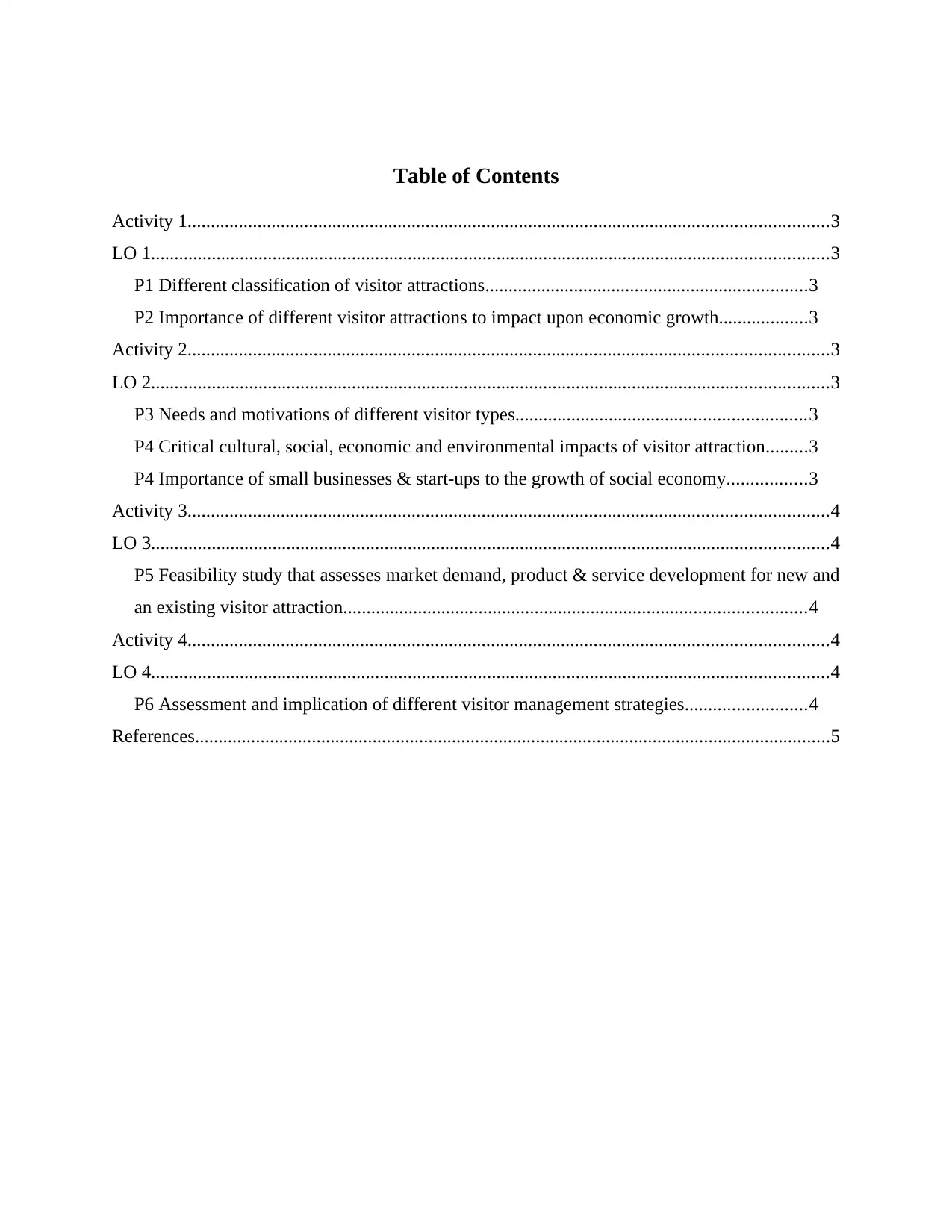
Table of Contents
Activity 1.........................................................................................................................................3
LO 1.................................................................................................................................................3
P1 Different classification of visitor attractions.....................................................................3
P2 Importance of different visitor attractions to impact upon economic growth...................3
Activity 2.........................................................................................................................................3
LO 2.................................................................................................................................................3
P3 Needs and motivations of different visitor types..............................................................3
P4 Critical cultural, social, economic and environmental impacts of visitor attraction.........3
P4 Importance of small businesses & start-ups to the growth of social economy.................3
Activity 3.........................................................................................................................................4
LO 3.................................................................................................................................................4
P5 Feasibility study that assesses market demand, product & service development for new and
an existing visitor attraction...................................................................................................4
Activity 4.........................................................................................................................................4
LO 4.................................................................................................................................................4
P6 Assessment and implication of different visitor management strategies..........................4
References........................................................................................................................................5
Activity 1.........................................................................................................................................3
LO 1.................................................................................................................................................3
P1 Different classification of visitor attractions.....................................................................3
P2 Importance of different visitor attractions to impact upon economic growth...................3
Activity 2.........................................................................................................................................3
LO 2.................................................................................................................................................3
P3 Needs and motivations of different visitor types..............................................................3
P4 Critical cultural, social, economic and environmental impacts of visitor attraction.........3
P4 Importance of small businesses & start-ups to the growth of social economy.................3
Activity 3.........................................................................................................................................4
LO 3.................................................................................................................................................4
P5 Feasibility study that assesses market demand, product & service development for new and
an existing visitor attraction...................................................................................................4
Activity 4.........................................................................................................................................4
LO 4.................................................................................................................................................4
P6 Assessment and implication of different visitor management strategies..........................4
References........................................................................................................................................5
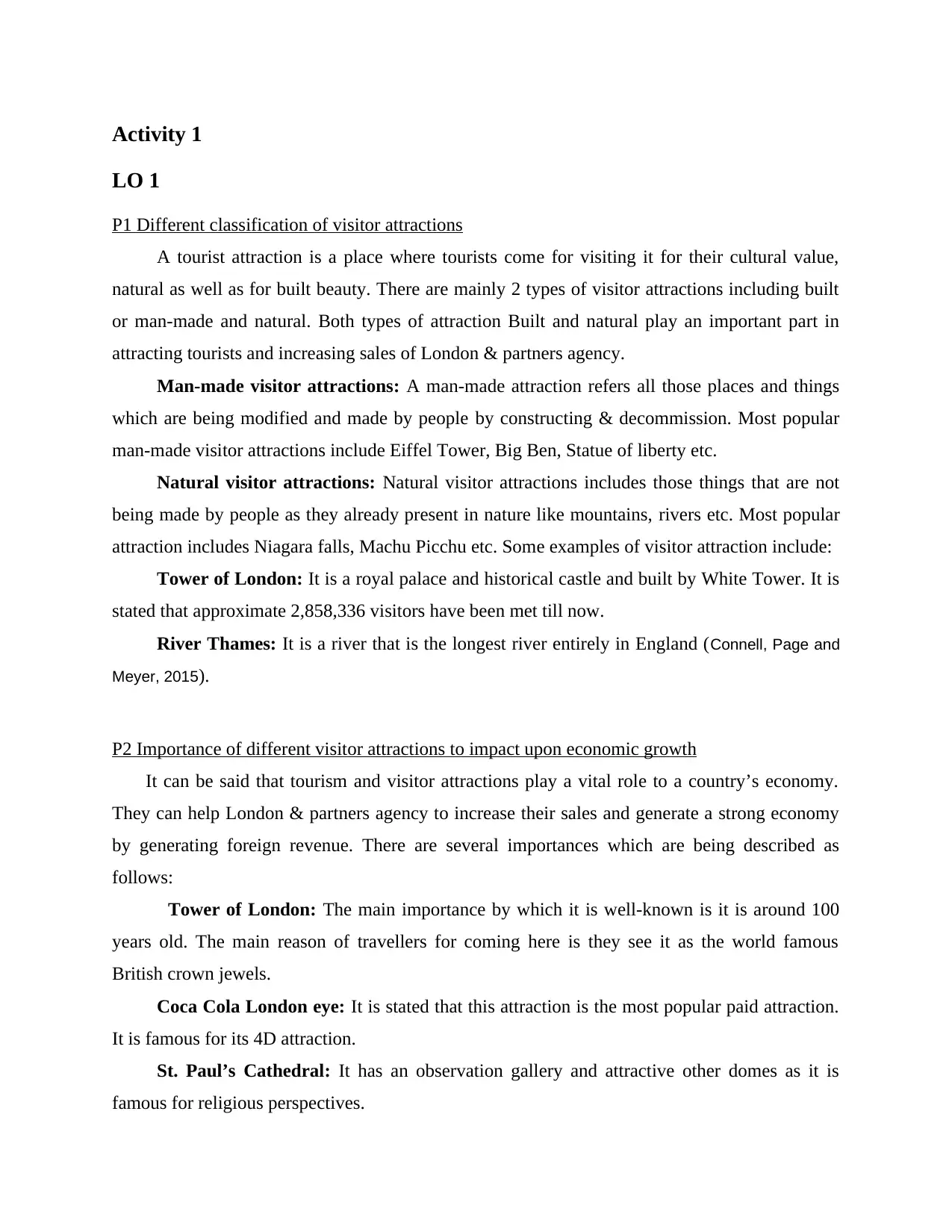
Activity 1
LO 1
P1 Different classification of visitor attractions
A tourist attraction is a place where tourists come for visiting it for their cultural value,
natural as well as for built beauty. There are mainly 2 types of visitor attractions including built
or man-made and natural. Both types of attraction Built and natural play an important part in
attracting tourists and increasing sales of London & partners agency.
Man-made visitor attractions: A man-made attraction refers all those places and things
which are being modified and made by people by constructing & decommission. Most popular
man-made visitor attractions include Eiffel Tower, Big Ben, Statue of liberty etc.
Natural visitor attractions: Natural visitor attractions includes those things that are not
being made by people as they already present in nature like mountains, rivers etc. Most popular
attraction includes Niagara falls, Machu Picchu etc. Some examples of visitor attraction include:
Tower of London: It is a royal palace and historical castle and built by White Tower. It is
stated that approximate 2,858,336 visitors have been met till now.
River Thames: It is a river that is the longest river entirely in England (Connell, Page and
Meyer, 2015).
P2 Importance of different visitor attractions to impact upon economic growth
It can be said that tourism and visitor attractions play a vital role to a country’s economy.
They can help London & partners agency to increase their sales and generate a strong economy
by generating foreign revenue. There are several importances which are being described as
follows:
Tower of London: The main importance by which it is well-known is it is around 100
years old. The main reason of travellers for coming here is they see it as the world famous
British crown jewels.
Coca Cola London eye: It is stated that this attraction is the most popular paid attraction.
It is famous for its 4D attraction.
St. Paul’s Cathedral: It has an observation gallery and attractive other domes as it is
famous for religious perspectives.
LO 1
P1 Different classification of visitor attractions
A tourist attraction is a place where tourists come for visiting it for their cultural value,
natural as well as for built beauty. There are mainly 2 types of visitor attractions including built
or man-made and natural. Both types of attraction Built and natural play an important part in
attracting tourists and increasing sales of London & partners agency.
Man-made visitor attractions: A man-made attraction refers all those places and things
which are being modified and made by people by constructing & decommission. Most popular
man-made visitor attractions include Eiffel Tower, Big Ben, Statue of liberty etc.
Natural visitor attractions: Natural visitor attractions includes those things that are not
being made by people as they already present in nature like mountains, rivers etc. Most popular
attraction includes Niagara falls, Machu Picchu etc. Some examples of visitor attraction include:
Tower of London: It is a royal palace and historical castle and built by White Tower. It is
stated that approximate 2,858,336 visitors have been met till now.
River Thames: It is a river that is the longest river entirely in England (Connell, Page and
Meyer, 2015).
P2 Importance of different visitor attractions to impact upon economic growth
It can be said that tourism and visitor attractions play a vital role to a country’s economy.
They can help London & partners agency to increase their sales and generate a strong economy
by generating foreign revenue. There are several importances which are being described as
follows:
Tower of London: The main importance by which it is well-known is it is around 100
years old. The main reason of travellers for coming here is they see it as the world famous
British crown jewels.
Coca Cola London eye: It is stated that this attraction is the most popular paid attraction.
It is famous for its 4D attraction.
St. Paul’s Cathedral: It has an observation gallery and attractive other domes as it is
famous for religious perspectives.
⊘ This is a preview!⊘
Do you want full access?
Subscribe today to unlock all pages.

Trusted by 1+ million students worldwide
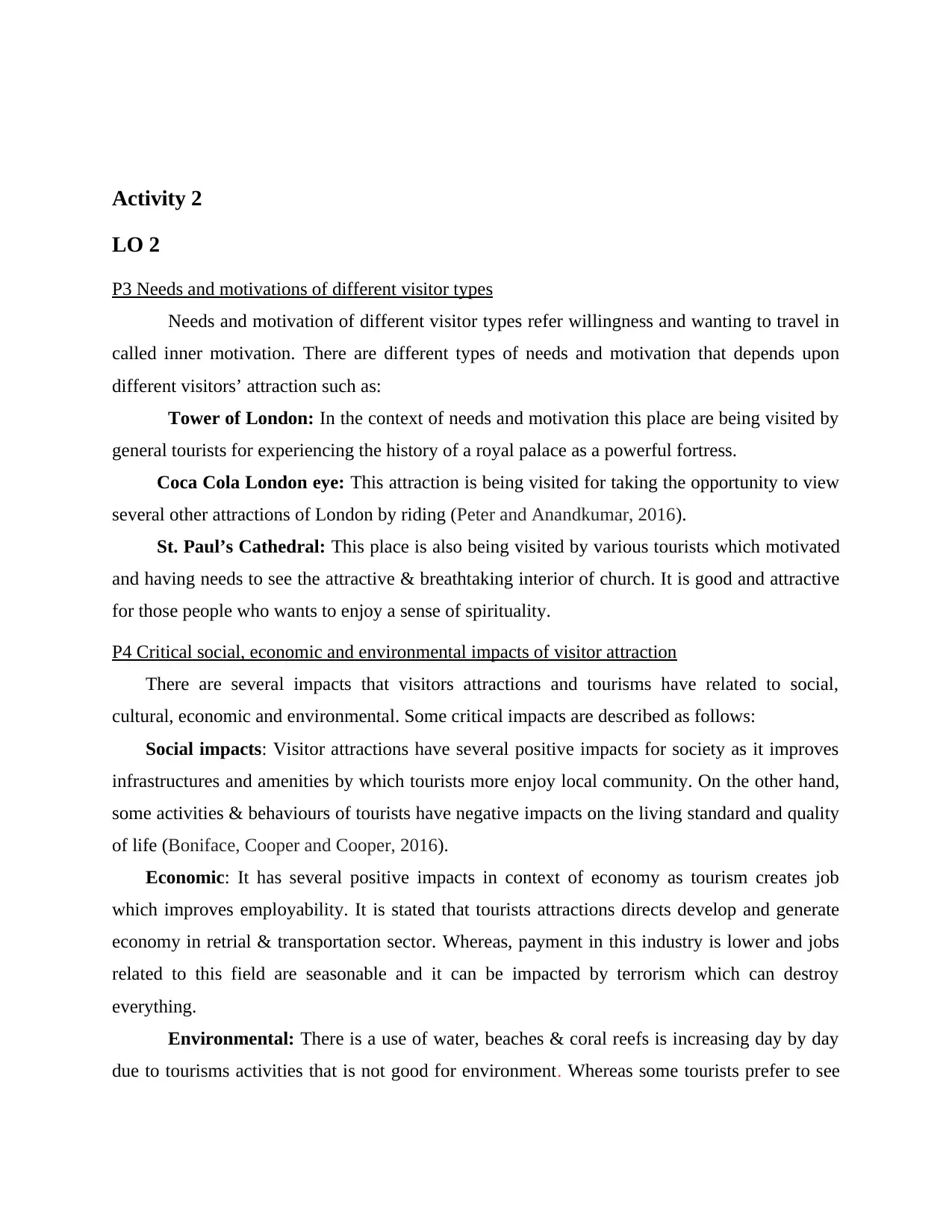
Activity 2
LO 2
P3 Needs and motivations of different visitor types
Needs and motivation of different visitor types refer willingness and wanting to travel in
called inner motivation. There are different types of needs and motivation that depends upon
different visitors’ attraction such as:
Tower of London: In the context of needs and motivation this place are being visited by
general tourists for experiencing the history of a royal palace as a powerful fortress.
Coca Cola London eye: This attraction is being visited for taking the opportunity to view
several other attractions of London by riding (Peter and Anandkumar, 2016).
St. Paul’s Cathedral: This place is also being visited by various tourists which motivated
and having needs to see the attractive & breathtaking interior of church. It is good and attractive
for those people who wants to enjoy a sense of spirituality.
P4 Critical social, economic and environmental impacts of visitor attraction
There are several impacts that visitors attractions and tourisms have related to social,
cultural, economic and environmental. Some critical impacts are described as follows:
Social impacts: Visitor attractions have several positive impacts for society as it improves
infrastructures and amenities by which tourists more enjoy local community. On the other hand,
some activities & behaviours of tourists have negative impacts on the living standard and quality
of life (Boniface, Cooper and Cooper, 2016).
Economic: It has several positive impacts in context of economy as tourism creates job
which improves employability. It is stated that tourists attractions directs develop and generate
economy in retrial & transportation sector. Whereas, payment in this industry is lower and jobs
related to this field are seasonable and it can be impacted by terrorism which can destroy
everything.
Environmental: There is a use of water, beaches & coral reefs is increasing day by day
due to tourisms activities that is not good for environment. Whereas some tourists prefer to see
LO 2
P3 Needs and motivations of different visitor types
Needs and motivation of different visitor types refer willingness and wanting to travel in
called inner motivation. There are different types of needs and motivation that depends upon
different visitors’ attraction such as:
Tower of London: In the context of needs and motivation this place are being visited by
general tourists for experiencing the history of a royal palace as a powerful fortress.
Coca Cola London eye: This attraction is being visited for taking the opportunity to view
several other attractions of London by riding (Peter and Anandkumar, 2016).
St. Paul’s Cathedral: This place is also being visited by various tourists which motivated
and having needs to see the attractive & breathtaking interior of church. It is good and attractive
for those people who wants to enjoy a sense of spirituality.
P4 Critical social, economic and environmental impacts of visitor attraction
There are several impacts that visitors attractions and tourisms have related to social,
cultural, economic and environmental. Some critical impacts are described as follows:
Social impacts: Visitor attractions have several positive impacts for society as it improves
infrastructures and amenities by which tourists more enjoy local community. On the other hand,
some activities & behaviours of tourists have negative impacts on the living standard and quality
of life (Boniface, Cooper and Cooper, 2016).
Economic: It has several positive impacts in context of economy as tourism creates job
which improves employability. It is stated that tourists attractions directs develop and generate
economy in retrial & transportation sector. Whereas, payment in this industry is lower and jobs
related to this field are seasonable and it can be impacted by terrorism which can destroy
everything.
Environmental: There is a use of water, beaches & coral reefs is increasing day by day
due to tourisms activities that is not good for environment. Whereas some tourists prefer to see
Paraphrase This Document
Need a fresh take? Get an instant paraphrase of this document with our AI Paraphraser
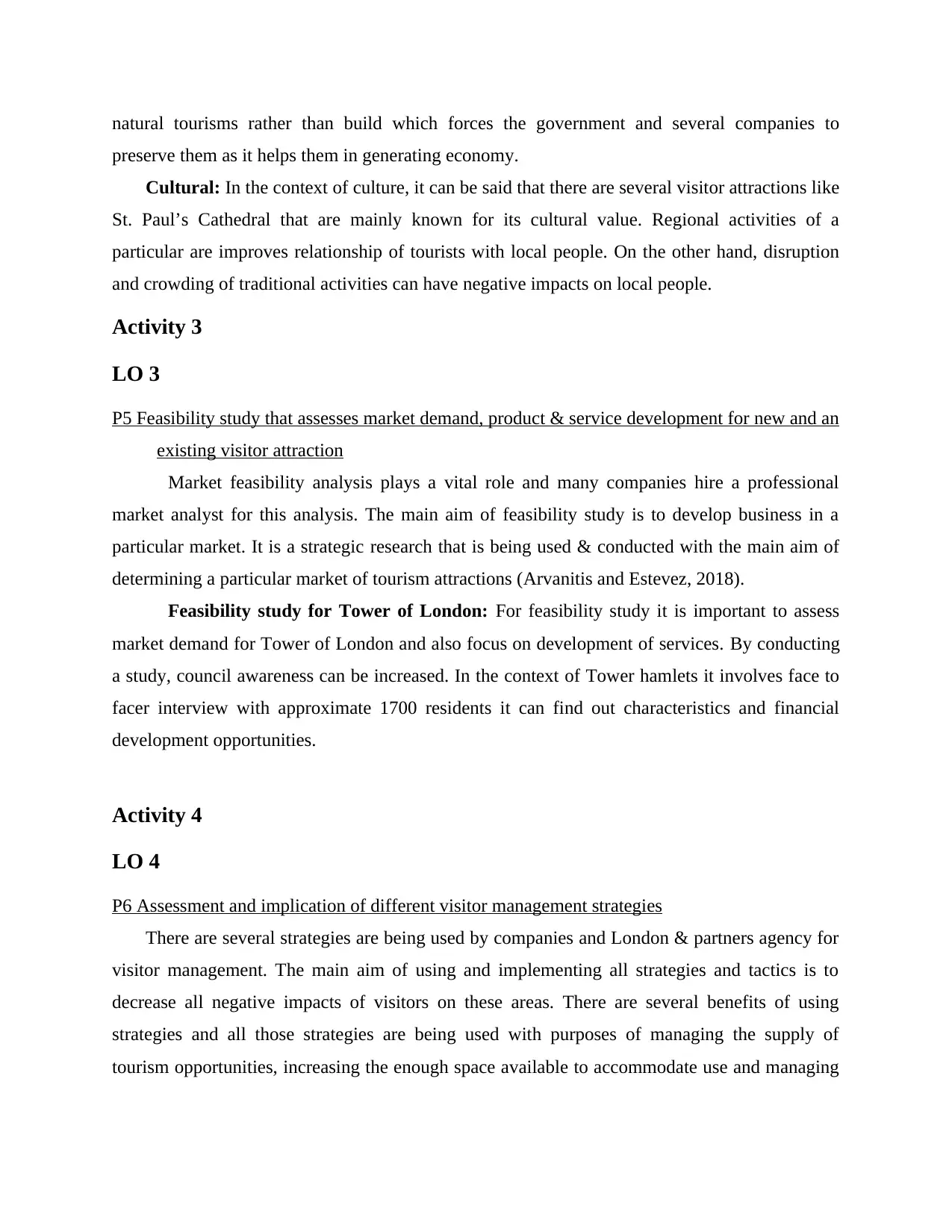
natural tourisms rather than build which forces the government and several companies to
preserve them as it helps them in generating economy.
Cultural: In the context of culture, it can be said that there are several visitor attractions like
St. Paul’s Cathedral that are mainly known for its cultural value. Regional activities of a
particular are improves relationship of tourists with local people. On the other hand, disruption
and crowding of traditional activities can have negative impacts on local people.
Activity 3
LO 3
P5 Feasibility study that assesses market demand, product & service development for new and an
existing visitor attraction
Market feasibility analysis plays a vital role and many companies hire a professional
market analyst for this analysis. The main aim of feasibility study is to develop business in a
particular market. It is a strategic research that is being used & conducted with the main aim of
determining a particular market of tourism attractions (Arvanitis and Estevez, 2018).
Feasibility study for Tower of London: For feasibility study it is important to assess
market demand for Tower of London and also focus on development of services. By conducting
a study, council awareness can be increased. In the context of Tower hamlets it involves face to
facer interview with approximate 1700 residents it can find out characteristics and financial
development opportunities.
Activity 4
LO 4
P6 Assessment and implication of different visitor management strategies
There are several strategies are being used by companies and London & partners agency for
visitor management. The main aim of using and implementing all strategies and tactics is to
decrease all negative impacts of visitors on these areas. There are several benefits of using
strategies and all those strategies are being used with purposes of managing the supply of
tourism opportunities, increasing the enough space available to accommodate use and managing
preserve them as it helps them in generating economy.
Cultural: In the context of culture, it can be said that there are several visitor attractions like
St. Paul’s Cathedral that are mainly known for its cultural value. Regional activities of a
particular are improves relationship of tourists with local people. On the other hand, disruption
and crowding of traditional activities can have negative impacts on local people.
Activity 3
LO 3
P5 Feasibility study that assesses market demand, product & service development for new and an
existing visitor attraction
Market feasibility analysis plays a vital role and many companies hire a professional
market analyst for this analysis. The main aim of feasibility study is to develop business in a
particular market. It is a strategic research that is being used & conducted with the main aim of
determining a particular market of tourism attractions (Arvanitis and Estevez, 2018).
Feasibility study for Tower of London: For feasibility study it is important to assess
market demand for Tower of London and also focus on development of services. By conducting
a study, council awareness can be increased. In the context of Tower hamlets it involves face to
facer interview with approximate 1700 residents it can find out characteristics and financial
development opportunities.
Activity 4
LO 4
P6 Assessment and implication of different visitor management strategies
There are several strategies are being used by companies and London & partners agency for
visitor management. The main aim of using and implementing all strategies and tactics is to
decrease all negative impacts of visitors on these areas. There are several benefits of using
strategies and all those strategies are being used with purposes of managing the supply of
tourism opportunities, increasing the enough space available to accommodate use and managing
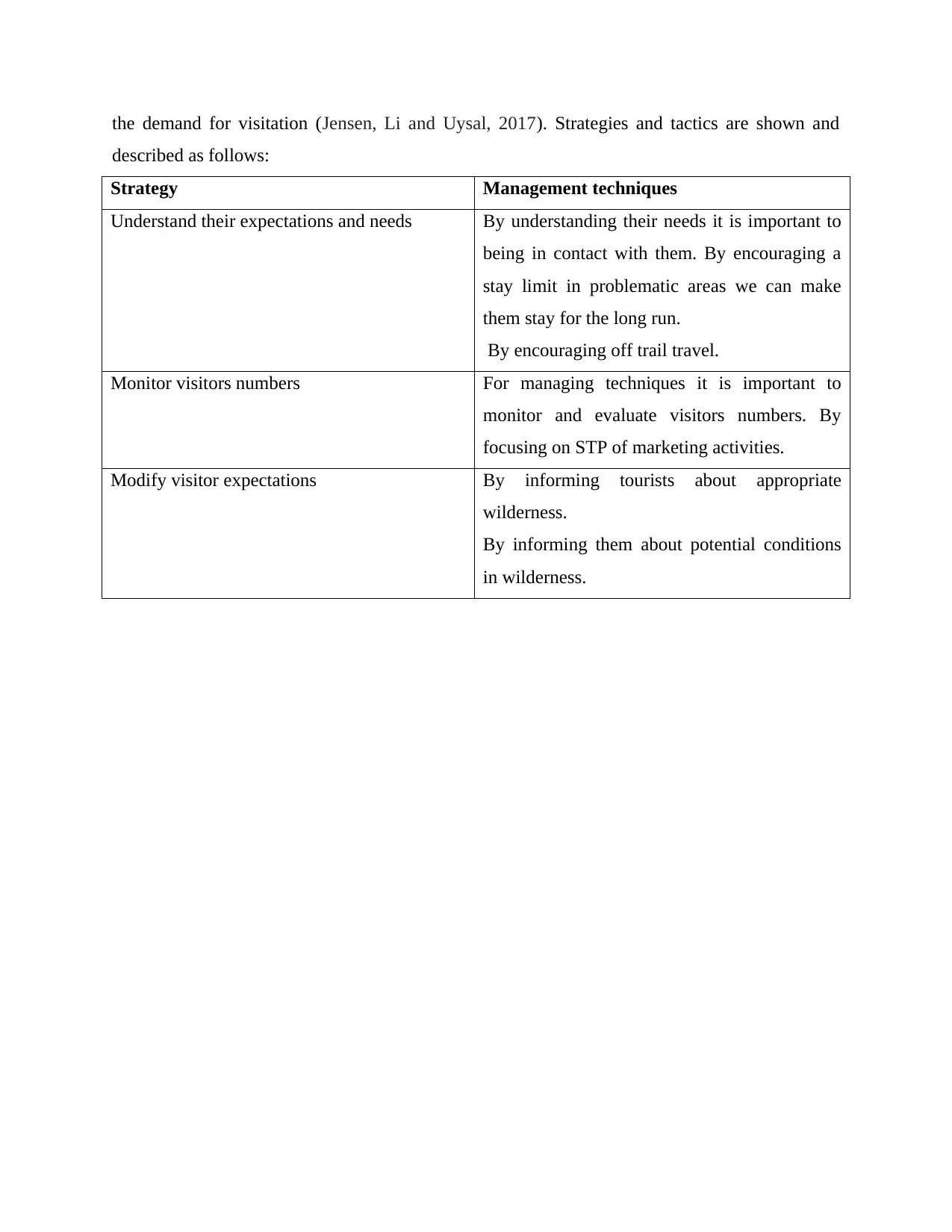
the demand for visitation (Jensen, Li and Uysal, 2017). Strategies and tactics are shown and
described as follows:
Strategy Management techniques
Understand their expectations and needs By understanding their needs it is important to
being in contact with them. By encouraging a
stay limit in problematic areas we can make
them stay for the long run.
By encouraging off trail travel.
Monitor visitors numbers For managing techniques it is important to
monitor and evaluate visitors numbers. By
focusing on STP of marketing activities.
Modify visitor expectations By informing tourists about appropriate
wilderness.
By informing them about potential conditions
in wilderness.
described as follows:
Strategy Management techniques
Understand their expectations and needs By understanding their needs it is important to
being in contact with them. By encouraging a
stay limit in problematic areas we can make
them stay for the long run.
By encouraging off trail travel.
Monitor visitors numbers For managing techniques it is important to
monitor and evaluate visitors numbers. By
focusing on STP of marketing activities.
Modify visitor expectations By informing tourists about appropriate
wilderness.
By informing them about potential conditions
in wilderness.
⊘ This is a preview!⊘
Do you want full access?
Subscribe today to unlock all pages.

Trusted by 1+ million students worldwide
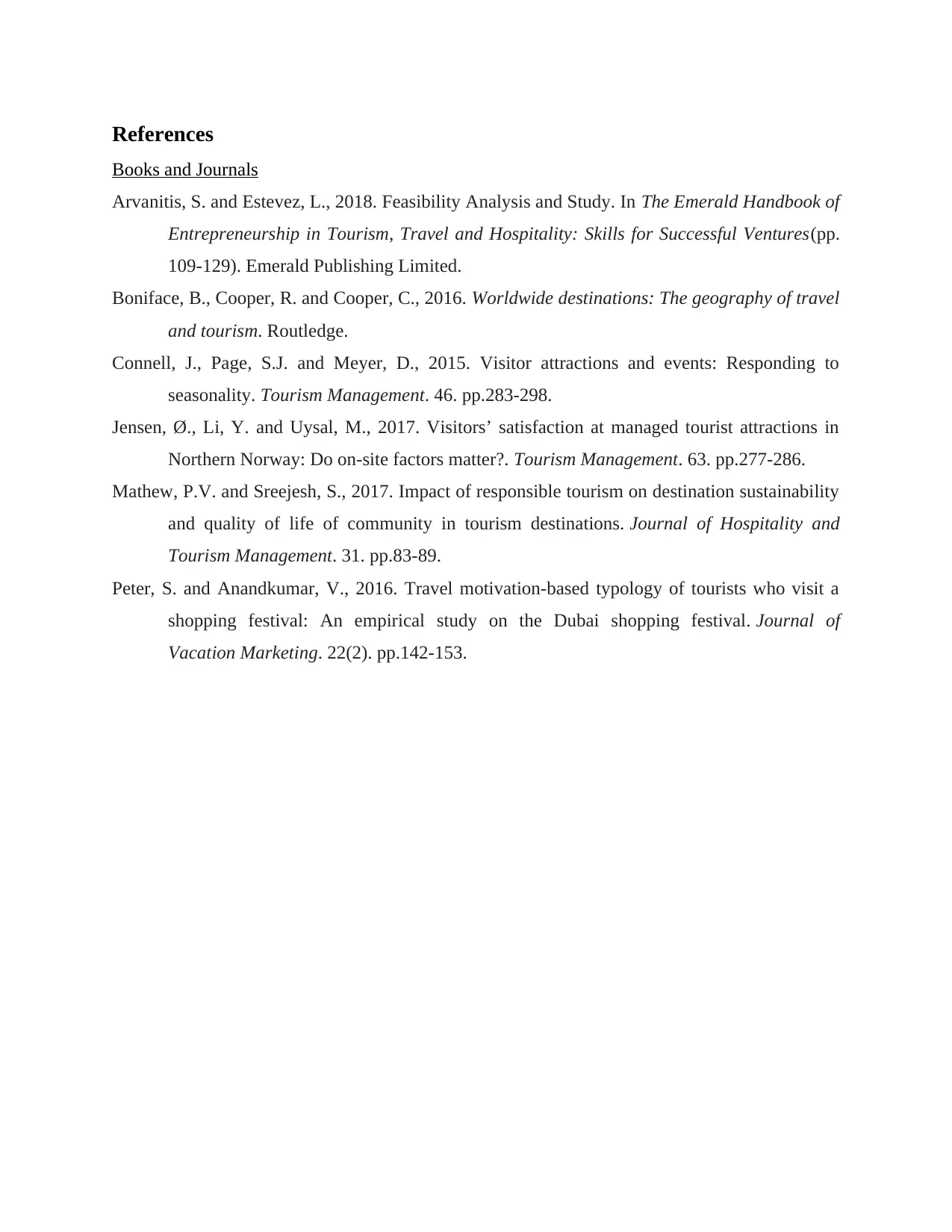
References
Books and Journals
Arvanitis, S. and Estevez, L., 2018. Feasibility Analysis and Study. In The Emerald Handbook of
Entrepreneurship in Tourism, Travel and Hospitality: Skills for Successful Ventures(pp.
109-129). Emerald Publishing Limited.
Boniface, B., Cooper, R. and Cooper, C., 2016. Worldwide destinations: The geography of travel
and tourism. Routledge.
Connell, J., Page, S.J. and Meyer, D., 2015. Visitor attractions and events: Responding to
seasonality. Tourism Management. 46. pp.283-298.
Jensen, Ø., Li, Y. and Uysal, M., 2017. Visitors’ satisfaction at managed tourist attractions in
Northern Norway: Do on-site factors matter?. Tourism Management. 63. pp.277-286.
Mathew, P.V. and Sreejesh, S., 2017. Impact of responsible tourism on destination sustainability
and quality of life of community in tourism destinations. Journal of Hospitality and
Tourism Management. 31. pp.83-89.
Peter, S. and Anandkumar, V., 2016. Travel motivation-based typology of tourists who visit a
shopping festival: An empirical study on the Dubai shopping festival. Journal of
Vacation Marketing. 22(2). pp.142-153.
Books and Journals
Arvanitis, S. and Estevez, L., 2018. Feasibility Analysis and Study. In The Emerald Handbook of
Entrepreneurship in Tourism, Travel and Hospitality: Skills for Successful Ventures(pp.
109-129). Emerald Publishing Limited.
Boniface, B., Cooper, R. and Cooper, C., 2016. Worldwide destinations: The geography of travel
and tourism. Routledge.
Connell, J., Page, S.J. and Meyer, D., 2015. Visitor attractions and events: Responding to
seasonality. Tourism Management. 46. pp.283-298.
Jensen, Ø., Li, Y. and Uysal, M., 2017. Visitors’ satisfaction at managed tourist attractions in
Northern Norway: Do on-site factors matter?. Tourism Management. 63. pp.277-286.
Mathew, P.V. and Sreejesh, S., 2017. Impact of responsible tourism on destination sustainability
and quality of life of community in tourism destinations. Journal of Hospitality and
Tourism Management. 31. pp.83-89.
Peter, S. and Anandkumar, V., 2016. Travel motivation-based typology of tourists who visit a
shopping festival: An empirical study on the Dubai shopping festival. Journal of
Vacation Marketing. 22(2). pp.142-153.
1 out of 7
Related Documents
Your All-in-One AI-Powered Toolkit for Academic Success.
+13062052269
info@desklib.com
Available 24*7 on WhatsApp / Email
![[object Object]](/_next/static/media/star-bottom.7253800d.svg)
Unlock your academic potential
Copyright © 2020–2025 A2Z Services. All Rights Reserved. Developed and managed by ZUCOL.





